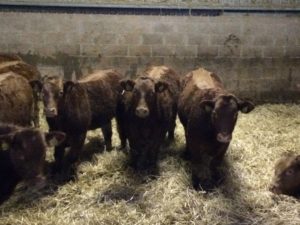Milder Winters
1 February 2017 There is no doubt winters are getting milder. Unfortunately however the growth of a “winter coat” in cattle is controlled by day length not temperature. This puts them under a lot more stress over the winter than our traditional cold winters did. The reason is that with their winter coats they overheat relatively quickly if they are housed. The only way that they can avoid this is by eating less, as it is digestion of food which produces the most heat. As a consequence feed intakes fall putting them under even more stress which then begins to depress their immune response, making them more susceptible to disease.
There is no doubt winters are getting milder. Unfortunately however the growth of a “winter coat” in cattle is controlled by day length not temperature. This puts them under a lot more stress over the winter than our traditional cold winters did. The reason is that with their winter coats they overheat relatively quickly if they are housed. The only way that they can avoid this is by eating less, as it is digestion of food which produces the most heat. As a consequence feed intakes fall putting them under even more stress which then begins to depress their immune response, making them more susceptible to disease.
It is now common practice to clip the backs of cattle, particularly young cattle when they are housed in the autumn to help them lose heat, but is there anything else we can do? Some points to consider would be –
Clip Cattle Twice
Clip young and finishing cattle twice over the winter – first at housing and again around the turn of the year. It is amazing how much of the winter coat is replaced in just a couple of months. For those with weigh crates or in a monitor farming group this would make an excellent small trial. Clip and weigh the cattle at housing and at the turn of the year clip every other one as they go through the weigh crate and then weigh them all again at turnout. My guess would be there could be at least an extra 5 kg per head achieved from the second clip. Intensively finished bulls in particular are likely to benefit from being clipped twice.
Outwintered Cattle
Consider clipping cattle which were outwintered. The risk is that in very wet windy conditions they would use some of the energy they eat to keep themselves warm but it is likely to be less than the increased performance for the rest of the winter by the animals eating more by being better able to control their body temperature? (Another trial?)
Breeding Cows
Should we clip the backs of breeding cows? For autumn calving cows the answer is definitely yes – they are eating more than a spring calver and as a result producing more heat. Any extra food they eat will help their condition and in particular fertility.
For spring calving cows the recommendation will depend on their condition at weaning. Lean cows and first calved heifers should also most certainly be clipped again to help improve their intake and hence allow them to regain condition ready for calving next spring. However for fit cows and in particular fat cows I would not clipping them in the hope that to control their temperature they would be forced to eat less and hence hopefully lose slightly more condition.
Breeding Bulls
I would clip the backs of breeding bulls (assuming I could do it safely) if they were –
- Working in an autumn calving herd due to their increased physical exercise and due to the possible benefit to fertility by helping them keep their body temperature and hence testicle temperature lower.
- Young and/or lean bulls which need to recover condition over the winter ready to go out with cows next spring. (Remember a bull with a mature weight of 1,000 kg will need to gain around 0.75 kg per day if he is to put on one unit of condition over the winter.)
Basil Lowman, basil.lowman@sac.co.uk
Sign up to the FAS newsletter
Receive updates on news, events and publications from Scotland’s Farm Advisory Service
